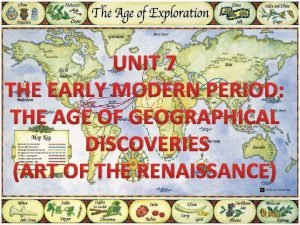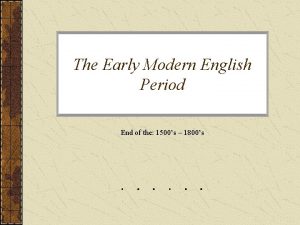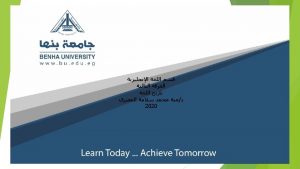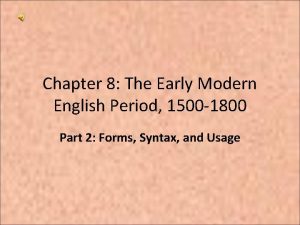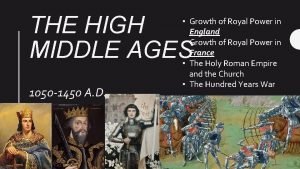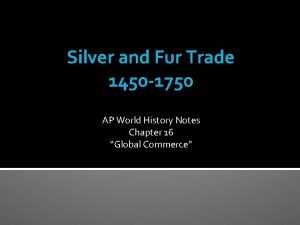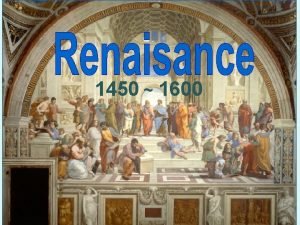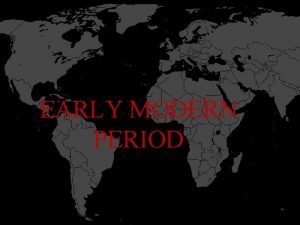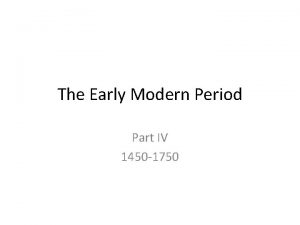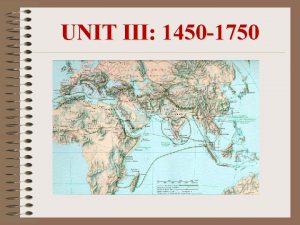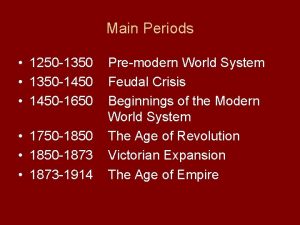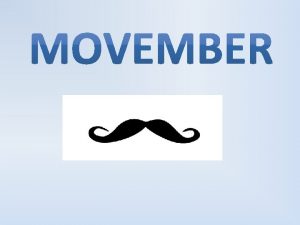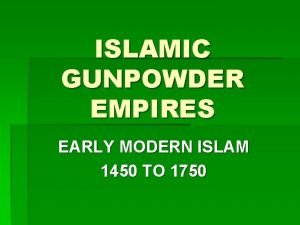Time Period IV THE EARLY MODERN PERIOD 1450















- Slides: 15

Time Period IV: THE EARLY MODERN PERIOD, (1450 -1750) “THE WORLD SHRINKS”

The World Map Changes � � Several European countries acquire OVERSEAS EMPIRES New LAND BASED EMPIRES emerge in Asia and eastern Europe � Russian, Ottoman, Safavid, and Mughal empires � GLOBAL TRADE ROUTES – no longer just Afro -Eurasia � Atlantic and Pacific routes established by 1750 � The Americas and Oceania now part of global network

Major Political Units, c. 1450

Major Political Units, c. 1750

Triggers for Change � REVIVAL OF EMPIRE BUILDING � Ottoman Empire– notable example � Steady progression of EXPLORATION by Europeans along Atlantic coast of Africa � Motivated by desire to find ways to trade with east Asia while circumventing Muslim-controlled regions � TECHNOLOGICAL ADVANCES � Compasses and navigational devices � Better ship designs and building � Guns and gunpowder

The Big Changes � A New GLOBAL ECONOMY � International trade increased in volume � Americas brought in to network for 1 st time � Proto-globalization ▫ Commerce was global � Intensity of contacts increased ▫ More people now involved ▫ Influenced political and social systems in addition to commercial ones � Migration across oceans ▫ Some forced

The Big Changes � Biological Exchange � All manner of living things now moved or were moved around the world ▫ ▫ Foods from the Americas Diseases from Europe Slaves from Africa Animals, plants, technologies � Columbian Exchange altered many relationships

New Empires � New empires represented significant SHIFTS IN POWER � Gunpowder empires– large political units � � New land-based empires challenged political traditions in imperial territories Forming of “multinational” units � Different cultures and ethnic groups embraced � World position of western Europe increased � Russia found new role � Systematic patterns of inequality emerge

Continuity � � Preexisting trade routes continued to be important Culturally– great deal of continuity � Notable developments– new influence of science � Spread of world religions continued � Global contacts didn’t overrun regional patterns � � � Gender relations adhered to established patriarchal patterns No technological breakthroughs until after 1750 Politically � China prided itself on reviving and maintaining its system of government � African societies preserved earlier traditions of divine kingships

Impact on Daily Life: Work � Impact on ordinary people � Decimation of Native Americans due to influx of European and African immigrants ▫ Diseases– small pox and measles � Chinese taxation of peasantry ▫ Silver ● Need for new sources of money caused many to fall deeper into poverty � Millions of Africans seized and subjected to slavery ▫ Terrifying and often deadly passage to America

Impact on Daily Life: Work � Most general social change– pressure to work harder � World now increasingly commercial and crowded � Population increases demanded more from workers to sustain society � New forms of race-based slavery � Increase in child labor � Masters compelled workers to increase production

Trends and Societies in the Early Modern Period � Chapter 16: THE WORLD ECONOMY � New global trading patterns � Changes in naval technology and warfare � Chapter 17: TRANSFORMATION OF THE WEST � New trading opportunities and colonial expansion � Chapters 19: EARLY LATIN AMERICA � Formative period for new society in Latin America � Chapter 20: AFRICA AND THE ATLANTIC SLAVE TRADE

Trends and Societies in the Early Modern Period � Chapter 18: THE RISE OF RUSSIA � Russia– Westernization; gunpowder empire � Major impact on power balance in eastern Europe � Chapter 21: MUSLIM EMPIRES � New Muslim states in the Middle East and south Asia � Emergence of other gunpowder empires � � Chapter 22: ASIAN TRANSITIONS Dynastic rebirth in China and Isolation in Japan

Trends and Societies in the Early Modern Period � Each chapter deals with reactions to world trade, biological exchange, and new pressures on labor � Highlights diversity of patterns, depending on cultural orientation and shifts in positions of power

Key Concepts � Globalizing Networks of Communication and Exchange �Global Trade �Tech and Innovation � New forms of Social Organization and Modes of Production �Commercial Markets �Columbian Exchange �Religious Changes �Arts and Education � State Consolidation and Imperial Expansion �Rulers �Early Imperialism and Militarism �International and Regional Competition
 Early modern period dates
Early modern period dates British literary movements timeline
British literary movements timeline Early modern english period
Early modern english period French period floral arrangements
French period floral arrangements Byzantine floral design history
Byzantine floral design history Modern english time period
Modern english time period Early cpr and early defibrillation can: *
Early cpr and early defibrillation can: * Early modern english syntax
Early modern english syntax Early modern english
Early modern english Archaic pronouns
Archaic pronouns Counterpart theory of the positivist school of criminology
Counterpart theory of the positivist school of criminology Start time end time and elapsed time
Start time end time and elapsed time Mughal empire 1450 to 1750
Mughal empire 1450 to 1750 1450 ad
1450 ad St george country radio stations
St george country radio stations Silver trade 1450 to 1750
Silver trade 1450 to 1750
